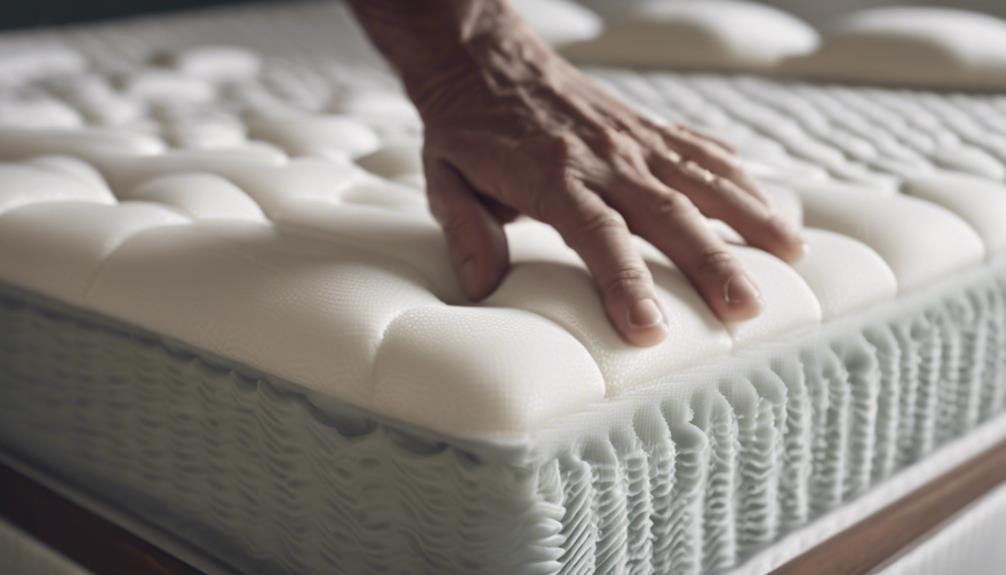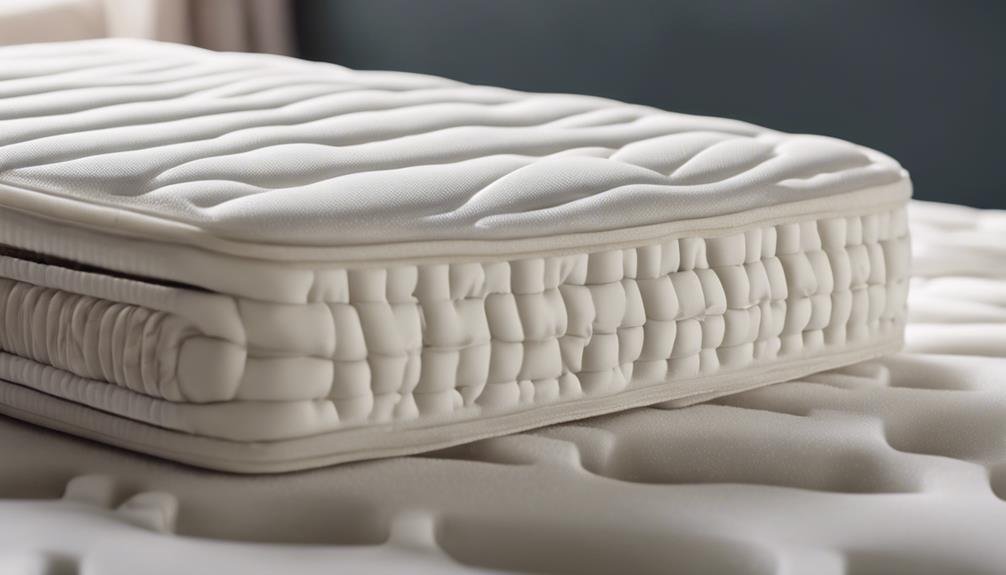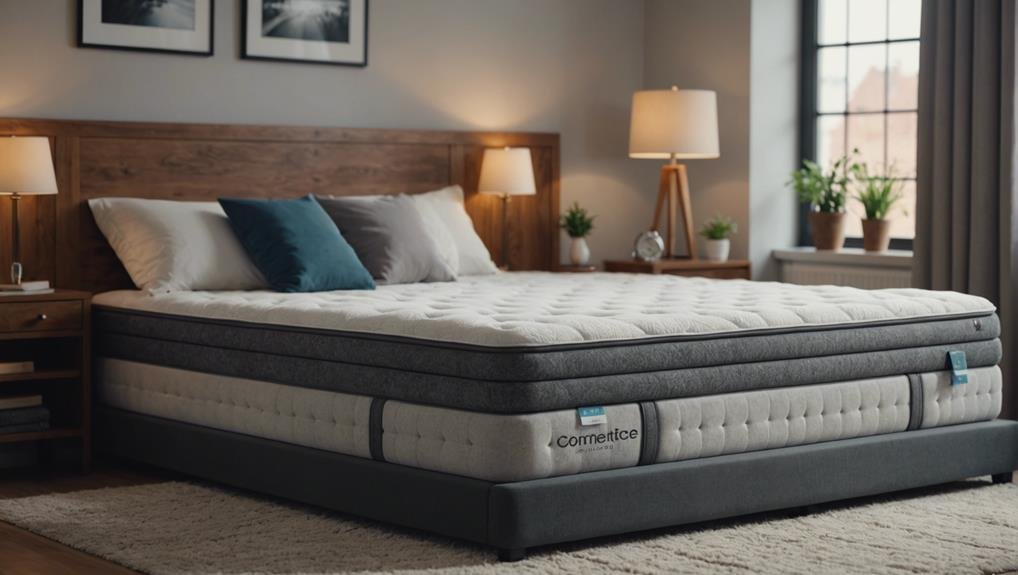When you're choosing between memory foam and spring mattresses, it's important to weigh specific factors that influence comfort and longevity. You'll want to think about pressure relief and how each type supports your body. Firmness options and cooling features also play significant roles in your decision. Don't overlook durability, motion isolation, and price, as these factors impact long-term satisfaction. Memory foam contours to your body but may trap heat, while spring mattresses offer better airflow but varying firmness levels. Curious about which mattress suits your needs best? Let's explore these tips to guide your choice.
Key Takeaways
- Memory foam provides superior pressure relief and maintains proper spinal alignment compared to spring mattresses.
- Spring mattresses offer better airflow naturally, which helps in keeping the mattress cool.
- Memory foam mattresses have better motion isolation, minimizing disturbances from partner movements.
- Spring mattresses are generally more budget-friendly but may need replacement sooner than memory foam.
- Memory foam mattresses tend to be more durable, lasting up to 15 years with proper maintenance.
Pressure Relief
When it comes to pressure relief, memory foam mattresses excel by contouring to your body's shape and evenly distributing weight. This happens thanks to the viscoelastic properties of memory foam, which allow it to conform to your body's pressure points. As a result, you'll experience reduced discomfort and better blood circulation throughout the night.
Unlike spring mattresses, which rely on coil springs for support, memory foam provides a unique level of pressure relief. The springs in traditional mattresses can create uneven pressure points, leading to discomfort, especially if you suffer from muscle or joint pain.
Memory foam, on the other hand, adapts to your body's contours, alleviating pressure on sensitive areas like your shoulders, hips, and lower back. This leads to a more comfortable sleep experience and can notably reduce muscle and joint pain.
Moreover, memory foam's ability to distribute weight evenly means that it supports your entire body without creating painful pressure points. This even weight distribution enhances your overall comfort and helps you wake up feeling refreshed and pain-free.
If pressure relief is a priority for you, memory foam mattresses are a superior choice over traditional spring options.
Support
Memory foam mattresses offer exceptional support by contouring to your body's shape, guaranteeing uniform pressure relief and spinal alignment. The high-density nature of memory foam means it adapts well to your unique body contours, providing consistent support that reduces pressure points. This feature is particularly beneficial for maintaining proper spinal alignment, which can help alleviate back pain and improve sleep quality.
In contrast, spring mattresses rely on coils for support, which mightn't distribute your weight as evenly. The type of coils used in spring mattresses can lead to variations in support and firmness. While some spring mattresses offer firmer support, they may lack the conformity that memory foam provides. Additionally, spring mattresses often provide more bounce and localized support, which can be a plus or minus depending on your preference.
Consider these key points when evaluating support:
- Memory Foam Density: High-density foam guarantees better weight distribution and pressure relief.
- Coils: Different coil types affect firmness and the mattress's ability to conform to your body.
- Bounce vs. Conformity: Spring mattresses offer bounce and localized support, whereas memory foam excels in overall body conformity.
When deciding between the two, think about what kind of support you need for a good night's rest.
Firmness

Firmness in mattresses plays a critical role in determining your comfort and sleep quality. Memory foam mattresses offer varying firmness levels, from soft to firm, catering to diverse sleep preferences. The firmness in memory foam is determined by the foam density and ILD (indentation load deflection) rating. Higher foam density and ILD ratings generally provide more support and firmness, ensuring consistent comfort and proper spinal alignment.
Spring mattresses, on the other hand, typically come in firm to medium-firm options. The firmness here is influenced by the coil type and gauge. Different coil types and gauges allow for customization, making it easier to find a mattress that suits your comfort and support needs.
To help you compare:
| Mattress Type | Factors Influencing Firmness | Benefits |
|---|---|---|
| Memory Foam | Foam density, ILD rating | Customizable firmness, pressure relief, spinal alignment |
| Spring | Coil type, gauge | Solid support, customizable firmness, bounce |
| Both | Various firmness levels | Tailored support and comfort |
Choosing the right firmness level is essential for spinal alignment and pressure relief. If you prefer a soft, contouring feel, a memory foam mattress with the right foam density and ILD rating might be ideal. If you like a firmer, bouncier feel, consider a spring mattress with the appropriate coil type and gauge.
Cooling
Cooling is an important factor to take into account, especially if you tend to sleep hot. Both memory foam and spring mattresses offer different cooling features that cater to your temperature preferences and sleeping habits.
Memory Foam Mattresses: Memory foam can trap heat due to its density, which might cause discomfort. However, many memory foam options include cooling features like gel infusions and open-cell designs to regulate temperature and enhance breathability. These additions help to mitigate heat retention and promote airflow, making them more suitable for hot sleepers.
Spring Mattresses: Spring mattresses naturally offer better airflow due to their coil structure. The gaps between the coils allow for excellent cooling, making spring mattresses a great choice if you struggle with sleeping hot. They don't require additional cooling features because their design inherently promotes air circulation.
Consider Your Preferences: Your temperature preferences and sleeping habits are important when choosing between memory foam and spring mattresses. If you prioritize a cooler sleep environment, a spring mattress might be ideal. Conversely, if you prefer the contouring comfort of memory foam, look for models with gel infusions and open-cell designs to maintain excellent cooling.
Durability

When considering durability, you'll notice that memory foam mattresses often outlast their spring counterparts. Memory foam's dense structure helps it maintain its shape and support over time, while spring mattresses can suffer from coil wear and uneven support.
Additionally, memory foam generally requires less maintenance to stay in good shape.
Longevity and Wear Patterns
Memory foam mattresses generally outlast spring mattresses, boasting a lifespan of 10-15 years compared to 7-10 years for their spring counterparts. When comparing Memory Foam Vs Spring Mattresses, memory foam's longevity is often attributed to its ability to distribute weight evenly and maintain its shape over time. The high-density foam composition in memory foam mattresses resists wear and tear more effectively than the coils found in spring mattresses.
Wear patterns also differ notably between the two types. Memory foam mattresses show minimal wear patterns, while spring mattresses may sag or develop indentations sooner, affecting both their longevity and comfort. Proper weight distribution in memory foam helps it maintain its form, reducing the risk of sagging and indentations.
To enhance the durability and longevity of your mattress, consider these maintenance tips:
- Regular Rotation: Rotate your mattress every few months to ensure even wear.
- Proper Support: Use a sturdy bed frame to prevent sagging, especially for spring mattresses.
- Protective Cover: Invest in a good-quality mattress protector to shield against spills, stains, and allergens.
Material Breakdown Over Time
Understanding how materials break down over time is crucial to making an informed choice between memory foam and spring mattresses. Memory foam mattresses generally outlast spring mattresses, with a lifespan of 10-15 years compared to 7-10 years for spring mattresses.
The metal coils in spring mattresses are prone to coil compression, which leads to sagging and a loss of support. This wear and tear can cause discomfort and reduce the spring mattress lifespan.
On the other hand, memory foam durability is impressive. The consistent foam structure and density guarantee it maintains its shape and supportiveness over many years. Memory foam doesn't develop dips or valleys, providing lasting comfort and even support throughout its life. This makes it a reliable choice if you're looking for a mattress that remains comfortable and supportive for a longer period.
Spring mattresses, while initially bouncy, often lose their resilience as the coils weaken over time. This can result in a less supportive sleeping surface. Conversely, memory foam retains its original form, offering consistent performance and quality.
If long-term comfort and durability are your priorities, memory foam's structure and density make it a superior option.
Maintenance and Care Requirements
To maximize the lifespan of your mattress, regular maintenance and proper care are crucial. Memory foam mattresses and spring mattresses each have unique requirements to guarantee they last as long as possible.
Memory foam mattresses, known for their durability, typically last 10-15 years. To maintain even wear and prevent sagging, rotate them every six months. Fortunately, they're less prone to lumps and indentations compared to spring mattresses.
Spring mattresses have a slightly shorter lifespan, around 7-10 years, and require more frequent attention. To avoid sagging and maintain support, you should flip and rotate them regularly. This helps distribute the wear more evenly across the mattress, prolonging its life.
Regardless of the type, both memory foam and spring mattresses benefit from using a mattress protector. A mattress protector shields against spills, stains, and debris, contributing to the overall longevity and hygiene of your mattress.
Here are three key maintenance tips:
- Rotate Memory Foam Mattresses: Every six months to ensure even wear.
- Flip and Rotate Spring Mattresses: More frequently to prevent sagging.
- Use a Mattress Protector: To protect against spills, stains, and debris.
Motion Isolation
When it comes to motion isolation, memory foam mattresses stand out by absorbing movements and keeping disturbances to a minimum. This feature is particularly beneficial for couples.
Memory foam mattresses excel at motion isolation because their dense construction dampens vibrations, guaranteeing an undisturbed sleep. So, when your partner tosses and turns, you won't feel a thing, allowing you to enjoy a peaceful sleep environment.
In contrast, spring mattresses often struggle with motion isolation. The interconnected coils in these mattresses tend to transmit movement across the bed, causing more noticeable disturbances.
If your partner gets up frequently during the night, you'll likely feel those movements, which can disrupt your sleep.
Choosing a memory foam mattress can greatly reduce disruptions caused by a partner's movements during the night. The material's ability to absorb and localize movement ensures that you both sleep soundly, regardless of the other's activity.
This makes memory foam an ideal choice for anyone who shares a bed and values undisturbed sleep. Ultimately, if motion isolation is a priority for you, memory foam mattresses are the superior option compared to spring mattresses.
Price

When considering the price, you'll notice that memory foam mattresses often have a higher initial purchase cost compared to spring mattresses.
However, it's important to think about the long-term investment value, as memory foam tends to be more durable.
If you're on a budget, spring mattresses offer more affordable options without compromising on comfort.
Initial Purchase Cost
Comparing initial purchase costs, memory foam mattresses usually have a higher price tag than spring mattresses, reflecting their advanced materials and construction. When you're looking at the Memory Foam Vs Spring Mattresses debate, the initial purchase cost is an important factor to take into account.
Memory foam mattresses often range from $500 to $2000 for a queen size, with higher-end models featuring additional perks like cooling technology or organic materials reaching upwards of $3000. This cost difference arises because memory foam mattresses are crafted using specialized materials that offer superior comfort and support.
On the other hand, spring mattresses are generally more budget-friendly. A queen-size spring mattress typically costs between $200 and $1000. Their affordability makes them an attractive option, especially if you're on a tighter budget. However, it's essential to weigh this against the long-term value and durability of the mattress.
Here's a quick pricing comparison to help you make an informed decision:
- Memory Foam Mattresses: $500 – $3000+
- Spring Mattresses: $200 – $1000
- Key Factors Influencing Price: Advanced materials (memory foam), additional features (cooling tech), and overall durability
When considering mattress features, remember that the initial purchase cost isn't the only factor; long-term comfort and durability also play important roles.
Long-term Investment Value
Investing in a memory foam mattress might cost you more upfront, but its longevity and consistent comfort make it a wise long-term choice. Memory foam mattresses are known for their durability and ability to maintain support over many years, thanks to the high-quality materials used in their construction. This means you won't need to replace your mattress as frequently, making it a cost-effective option when you consider the long-term investment.
In contrast, spring mattresses may seem more budget-friendly initially. However, they often wear out faster, losing their support and comfort more quickly. This can lead to the need for earlier replacement, potentially increasing your overall expenditure in the long run. The true value of a mattress isn't just in the initial cost but in how well it performs over time.
When you factor in the lifespan and consistent performance of memory foam mattresses, their higher initial price becomes justified. These mattresses provide enduring comfort and support, making them a smart investment for your health and wallet. By choosing memory foam, you're opting for a product that delivers true value through its superior durability and long-term benefits.
Budget-Friendly Options
Finding a budget-friendly mattress can be challenging, but understanding the price differences between innerspring and memory foam options can help you make an informed decision. Innerspring mattresses are generally more budget-friendly, with prices ranging from around $200 to $2000, depending on the brand and features.
On the other hand, memory foam mattresses tend to be pricier, starting at $500 and going up to $4000 or more for high-end models. Consider the long-term investment when choosing between a budget-friendly innerspring mattress and a higher-priced memory foam option.
While innerspring mattresses might save you money upfront, memory foam mattresses can offer better durability and comfort, potentially saving you money in the long run.
To find a quality mattress within your budget, keep an eye out for:
- Sales: Many retailers offer significant markdowns during holiday weekends and end-of-season sales.
- Discounts: Look for special discounts that brands might offer for first-time buyers, students, or military personnel.
- Promotions: Check online and in-store promotions, as they can provide additional savings or include free accessories.
Frequently Asked Questions
Which Mattress Is Better, Spring or Memory Foam?
Choosing between a spring and memory foam mattress really depends on your preferences. If you love a mattress that contours to your body and offers great pressure relief, go for memory foam. It's durable and fantastic for pain relief.
On the other hand, if you prefer a bouncy feel and better breathability, spring mattresses are your best bet. Just remember, spring mattresses might wear out quicker. Consider your sleep preferences, health, and budget.
Which Is Better, an Innerspring Mattress or a Memory Foam Mattress?
Choosing between an innerspring and a memory foam mattress depends on your needs. If you want a budget-friendly option with good airflow and bounce, go for an innerspring mattress.
If you need pain relief and personalized support, a memory foam mattress is better. Both types offer various firmness levels to suit your sleep preferences.
Ultimately, the best choice is the one that meets your comfort and support needs.
What Are the Disadvantages of Memory Foam Mattress?
When you choose a memory foam mattress, you might experience some drawbacks. There's often an initial chemical odor called off-gassing.
These mattresses can retain body heat, making them uncomfortable if you sleep hot. They're also heavier than spring mattresses, making them harder to move or rotate.
You might find a longer break-in period is needed, and some lack the bouncy feel you prefer.
Which Mattress Is Better for Back Spring or Foam?
When choosing between a spring or foam mattress for back support, consider your personal needs. Memory foam mattresses are great for contouring to your body and evenly distributing weight, which helps relieve pressure points.
In contrast, spring mattresses, especially those with firmer or pocketed coils, offer solid support and spine alignment. Ultimately, it depends on your sleeping habits and preferences.
Try both types to see which feels better for your back.
What Are the Benefits of Memory Foam Mattresses Over Spring Mattresses?
When it comes to choosing a new mattress, affordable memory foam mattress tips can be helpful. Memory foam mattresses are superior to spring mattresses in several ways. They offer better support, pressure relief, and motion isolation, making them a popular choice for a good night’s sleep.
Conclusion
When choosing between memory foam and spring mattresses, think about your personal needs. Memory foam offers great pressure relief and body contouring, while spring mattresses provide different firmness levels and better airflow.
Consider cooling features if you sleep hot and don't forget durability and motion isolation for a peaceful night's sleep.
Lastly, weigh the price against long-term value to make an informed decision. Your perfect mattress is out there—just decide what matters most to you!

